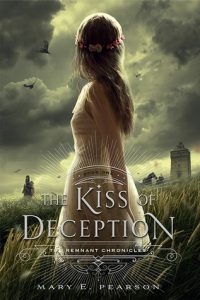
Mary E. Pearson
Henry Holt and Co.
Published on July 8th, 2014

Amazon | Barnes & Noble | Goodreads
About The Kiss of Deception
A princess must find her place in a reborn world.
She flees on her wedding day.
She steals ancient documents from the Chancellor’s secret collection.
She is pursued by bounty hunters sent by her own father.
She is Princess Lia, seventeen, First Daughter of the House of Morrighan.
The Kingdom of Morrighan is steeped in tradition and the stories of a bygone world, but some traditions Lia can’t abide. Like having to marry someone she’s never met to secure a political alliance.
Fed up and ready for a new life, Lia flees to a distant village on the morning of her wedding. She settles in among the common folk, intrigued when two mysterious and handsome strangers arrive—and unaware that one is the jilted prince and the other an assassin sent to kill her. Deceptions swirl and Lia finds herself on the brink of unlocking perilous secrets—secrets that may unravel her world—even as she feels herself falling in love.
My Review
Part fantasy, part dystopian, The Kiss of Deception was very unique book with some incredible writing. This book had one of the most unique ways of using narration to build up tension that I have ever seen in a book. I won’t go into details, as I don’t want to spoil it, but this book is one surprise after another.
I wasn’t sure if I was going to like this one at first, but once I got past the first few chapters I was completely sucked in. I really liked Lia, and rooted for her as she worked on building herself a new life. While I can’t say I agree with all of her choices, the characterization was believable and I can understand where she was coming from.
The world-building, while interesting, at times just didn’t piece together very well. I had a hard time believing some aspects of it (especially when the prophecy becomes a part of the story–I would have preferred had the author left the story uncomplicated by “chosen one” tropes). My only other gripes are the insta-love and love triangle clichés that are featured in this story (though those are fairly mild compared to some other books I have read/heard of).
The Kiss of Deception is a fantastic read for teens who love complex fantasy. I would rate it 4 out of 5 stars, and recommend it to readers 14 and up.
Cultural Elements
Major characters are white. One group of people is described as barbaric in comparison to the others.
Profanity/Crude Language Content
Some British-esque cursing.
Romance/Sexual Content
Kissing and caressing between a boy and girl. Also several scenes contain some sexual innuendo. Definitely sexual tension between characters, and one off-page scene could be interpreted as a sexual encounter. A woman is pregnant out of wedlock.
Spiritual Content
Mention of gods and goddesses. High-fantasy type religion and prophecy stuff, though not described in depth.
Violent Content
Strong violence in several scenes. Some disturbing (mostly emotionally, though graphic as well) deaths. Scars from abuse.
Drug Content
Characters drink wine.